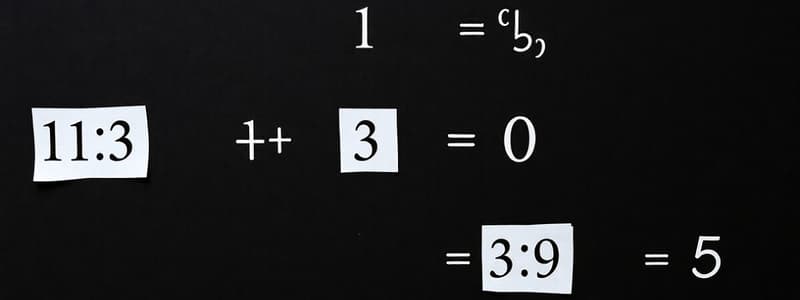Podcast
Questions and Answers
(______)⁵ = 2/3 × 2/3 × 2/3 × 2/3 × 2/3 × 2/3 × 2/3 × 2/3 × 2/3 × 2/3
(______)⁵ = 2/3 × 2/3 × 2/3 × 2/3 × 2/3 × 2/3 × 2/3 × 2/3 × 2/3 × 2/3
-7
(-5)³ = ?
(-5)³ = ?
-125
3³ = ?
3³ = ?
27
(1 1/3)² = ?
(1 1/3)² = ?
(53 - (-10)) ÷ (-3)² = ?
(53 - (-10)) ÷ (-3)² = ?
-6 - 1 × 3 1/3 = ?
-6 - 1 × 3 1/3 = ?
(-1/2 ÷ (-1/3)) + (1/3 ÷ (-3/4)) = ?
(-1/2 ÷ (-1/3)) + (1/3 ÷ (-3/4)) = ?
(-1/4)² + 18 x (2 - 5)² = ?
(-1/4)² + 18 x (2 - 5)² = ?
Flashcards
Exponential Form
Exponential Form
A base multiplied by itself a number of times, indicated by the exponent.
Expanded Form
Expanded Form
The expanded form shows the base multiplied by itself the number of times indicated by the exponent.
Standard Form
Standard Form
The value of a number raised to a power.
Exponent
Exponent
Signup and view all the flashcards
Base
Base
Signup and view all the flashcards
Power
Power
Signup and view all the flashcards
Order of Operations
Order of Operations
Signup and view all the flashcards
Evaluating Expressions
Evaluating Expressions
Signup and view all the flashcards
Negative Number
Negative Number
Signup and view all the flashcards
Multiplication
Multiplication
Signup and view all the flashcards
Addition
Addition
Signup and view all the flashcards
Subtraction
Subtraction
Signup and view all the flashcards
Division
Division
Signup and view all the flashcards
PEMDAS
PEMDAS
Signup and view all the flashcards
Order of Operations: Left-to-Right
Order of Operations: Left-to-Right
Signup and view all the flashcards
Variable
Variable
Signup and view all the flashcards
Algebraic Expression
Algebraic Expression
Signup and view all the flashcards
Equation
Equation
Signup and view all the flashcards
Inequality
Inequality
Signup and view all the flashcards
Constant
Constant
Signup and view all the flashcards
Rational Number
Rational Number
Signup and view all the flashcards
Irrational Number
Irrational Number
Signup and view all the flashcards
Sequence
Sequence
Signup and view all the flashcards
Common Difference
Common Difference
Signup and view all the flashcards
Arithmetic Sequence
Arithmetic Sequence
Signup and view all the flashcards
Rate
Rate
Signup and view all the flashcards
Central Tendency
Central Tendency
Signup and view all the flashcards
Measure of Variability
Measure of Variability
Signup and view all the flashcards
Mean
Mean
Signup and view all the flashcards
Median
Median
Signup and view all the flashcards
Mode
Mode
Signup and view all the flashcards
Graph
Graph
Signup and view all the flashcards
Study Notes
Exponents and Order of Operations
- Exponential Form to Expanded Form: Convert exponential expressions into their expanded form. For example, (-7)5 expands to (-7) x (-7) x (-7) x (-7) x (-7).
- Finding the Value of Exponential Expressions: Evaluate expressions like (-5)3 to determine their numerical value.
- Order of Operations (PEMDAS/BODMAS): Solve problems involving multiple operations. This includes parentheses/brackets, exponents, multiplication and division (from left to right), and addition and subtraction (from left to right).
- Number Lines for Addition and Subtraction: Use number lines to visualize addition and subtraction problems.
Mixed Numbers
- Answers should be in lowest terms when dealing with mixed numbers.
Studying That Suits You
Use AI to generate personalized quizzes and flashcards to suit your learning preferences.




